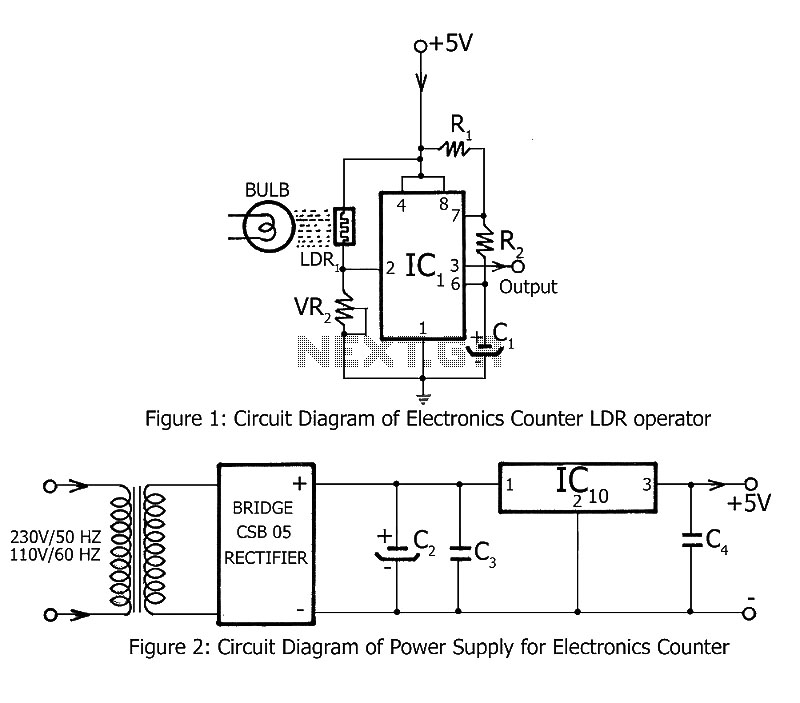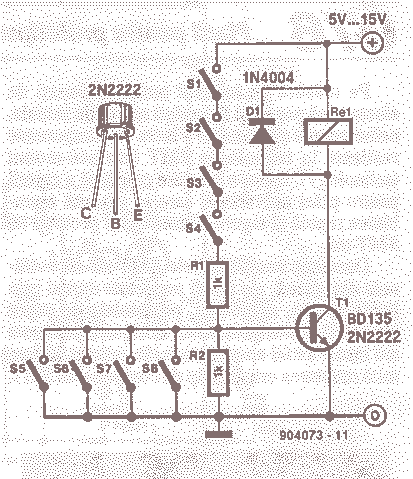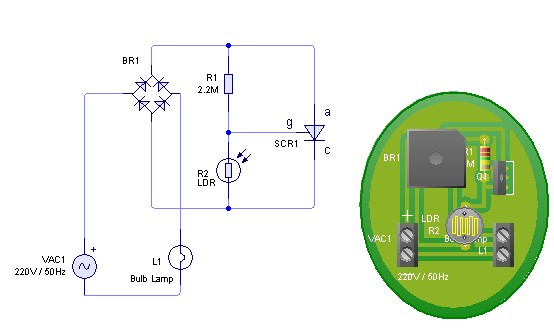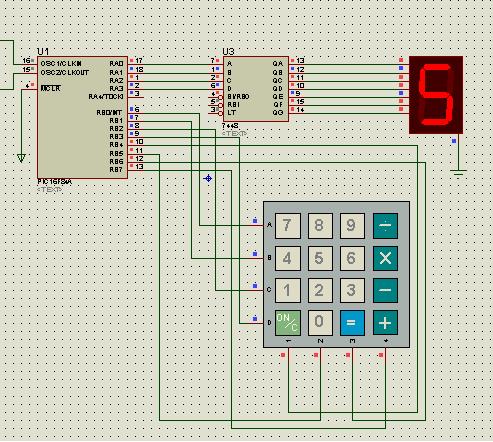
electronic mouse trap
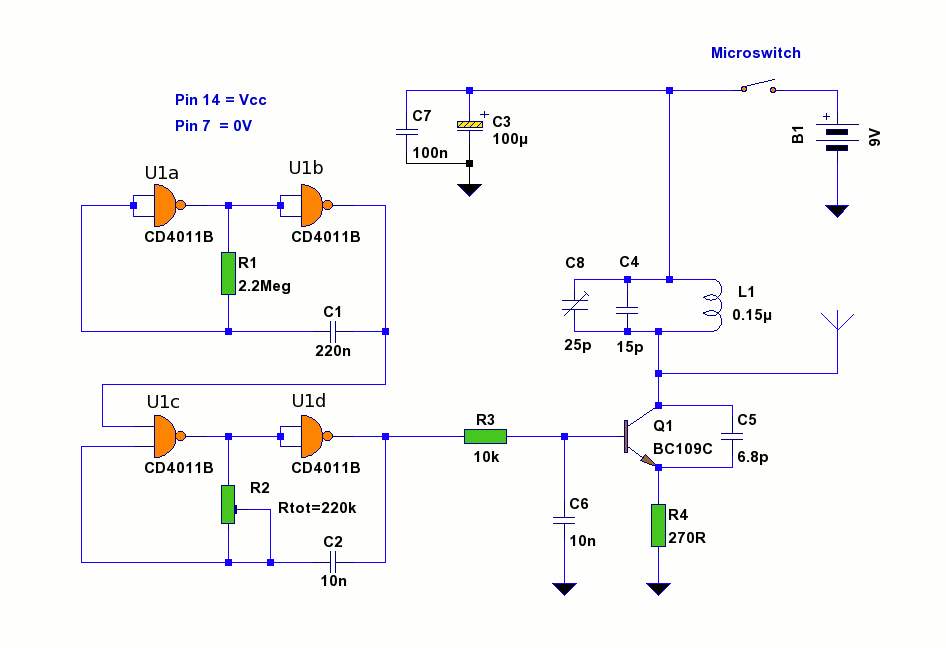
This circuit utilizes a conventional spring-loaded mouse trap, typically available at hardware stores. When a mouse is caught, the circuit activates and transmits an interrupted tone on the commercial FM band to a nearby radio receiver. It is a compact battery-powered transmitter that is triggered by the vibration from the mechanical mouse trap. This activation can be achieved using a microswitch positioned such that the circuit is off (not transmitting). When the mouse trap is triggered, the microswitch lever moves and activates the transmitter. The transmitter operates as a standard Hartley oscillator, designed to transmit across the FM band approximately from 87 to 108 MHz. The transmit frequency is adjustable using trimmer C8. The combined capacitance of C4 plus C8 and inductor L1 sets the resonant frequency. IC1 is a CMOS quad 2-input AND gate. Gates U1a and U1b create a square wave astable oscillator operating at about 2 Hz. The output from gate 1b is connected to the input of gate 1c. Similarly, gates 1c and 1d form another astable oscillator, this time operating at about 2 kHz. The 2 kHz oscillator is activated only when gate 1b is high, creating an interrupted oscillator. The tone of this oscillator is adjustable via the preset resistor R2. The output of the oscillator directly drives the transmitter, which consists of Q1 and associated components. The transmitter is activated when the output from gate 1c is high and deactivated when gate 1c is low. Due to the input signal being a square wave, there will be some cross modulation, resulting in the transmitter signal being audible at multiple points across the FM band. Given that the output power is limited, this is generally not an issue, and with just 5 inches of wire as an antenna, the transmitter can be received by an ordinary radio from 15 meters away. The antenna connects to the collector of Q1 and will function effectively with just a few inches of wire. A telescopic whip antenna may be used as an alternative. It is advised not to use wire lengths longer than 30 inches, as this could detune the oscillator and prevent the circuit from transmitting. L1 consists of 7 turns of 20 SWG wire wound around a 6 mm drill bit, forming an inductor of approximately 150 nH. The inductance value can be adjusted by compressing or expanding the turns. To construct L1, hold one end of the wire against the drill bit and wind the turns clockwise until all 7 turns are completed. Trim any excess wire so that both ends are the same length, and scrape about 3 mm of insulation off the opposite end. An additional feature of this circuit is the ability to monitor multiple mouse traps. This can be accomplished by building more identical circuits and tuning them to the same transmitting (RF) frequency. Each circuit must have R2 set to different values so that distinct notes are produced for each mouse trap. If two traps activate simultaneously, a "beat" note will be heard, which is the sum of the two different notes. A prototype of this circuit can be constructed on a breadboard. It should be noted that breadboard and veroboard have adjacent track capacitances of around 0.2 pF, which may limit the high-frequency response of the circuit. Although construction on veroboard is feasible, utilizing a PCB layout or copper-clad board with copper island construction is preferred for optimal performance.
This circuit design effectively combines mechanical and electronic systems to create a practical solution for monitoring mouse traps. The use of a Hartley oscillator allows for efficient FM transmission, while the adjustable frequency and tone settings provide flexibility in operation. The ability to monitor multiple traps enhances the functionality of the design, making it suitable for various applications in pest control. The careful consideration of component values, such as the inductance of L1 and the capacitance of C4 and C8, ensures that the circuit operates within the desired frequency range. Additionally, the choice of using a CMOS quad AND gate for generating oscillators is advantageous due to its low power consumption and high noise immunity. The design emphasizes the importance of maintaining proper antenna lengths to ensure effective transmission, which is crucial for reliable operation. Overall, this circuit exemplifies an innovative approach to integrating mechanical triggers with electronic signaling, showcasing the versatility of modern electronic engineering in addressing practical challenges.This circuit uses a conventional spring loaded mouse trap, available from hardware stores. However when a mouse is caught, the circuit triggers and transmits an interrupted tone on the commercial FM band to a nearby radio receiver. This circuit is a small battery powered transmitter which is activated by vibration from a mechanical mouse trap.
Thi s can be done using a microswitchpositioned so that the circuit is off (not transmitting). When the mouse trap is triggered the microswitch lever is moved and activates the transmitter. The transmitter is a standard hartley oscillator, designed to transmit across the FM band approximately, 87 to 108MHz. The transmit frequency is adjustableby means of trimmer C8. The combined capacitance of C4 plus C8 and L1 set the resonant frequency. IC1 is a CMOS quad 2 input AND gate. Gates U1a and U1b create a square wave astable oscillator ofabout 2Hz. The output of gate 1b is wired tothe input of gate 1c. Similarly gates 1c and 1d form another astable oscillator, this time about 2kHz. The 2kHz oscillator is activated only whengate 1b is high, all gates forming and interrupted oscillator.
The tone of this oscillator is adjustable via the preset R2. The output of the oscillator now directly drives the transmitter comprised of Q1 and associated components. The transmitter will be on when the output fromgate 1c is high and off when gate 1c is low. As the input signal is a sqaure wave, there will be some cross modulation and the transmitter signal willbe heard at more than one point across the FM band.
As the output power is limited, this is not really a problem and with just 5 inches of wire as anantenna, I could hear the transmitter with an ordinary radio 15 metres away. The antenna is connector to Q1 collwctor and will work with just a fewinches of wire. A telescopic whip may be used instead. Do not use lengths of wire longer than 30 inches as these will detune the oscillator andthe circuit may not transmit at all.
L1 is 7 turns of 20swg wire wound on a 6 mm drill bit. This forms an inductor of approximately 150 nH. The value of the inductance can be alteredby compressing or expanding the turns. Hold one end of the wire against the drill bit and start to wind the turns clockwise. Continue until all 7 turns have been completed, and the coil looks like the image of the right hand side. Trim any excess wire so both ends are same length and scrape about 3mm of insulationoff the opposite end.
An added feature is that multiple mouse traps can be monitored. Simply build more identical circuits and tune them to the same transmitting (RF) frequency. R2 must be set different in each case so that a different note is heard for each mouse trap. If two traps activate simultaneously then a "beat" note willbe heard which will be the sum of two different notes. Finally a picture of my prototype on breadboard. Breadboard and veroboard have adjacent track capacitances of around 0. 2pF. This may not soundmuch but limits the high frequency response of any circuit. Although construction on veroboard is possible either a PCB layout or copper cladboard and copper island construction preferred.
🔗 External reference
This circuit design effectively combines mechanical and electronic systems to create a practical solution for monitoring mouse traps. The use of a Hartley oscillator allows for efficient FM transmission, while the adjustable frequency and tone settings provide flexibility in operation. The ability to monitor multiple traps enhances the functionality of the design, making it suitable for various applications in pest control. The careful consideration of component values, such as the inductance of L1 and the capacitance of C4 and C8, ensures that the circuit operates within the desired frequency range. Additionally, the choice of using a CMOS quad AND gate for generating oscillators is advantageous due to its low power consumption and high noise immunity. The design emphasizes the importance of maintaining proper antenna lengths to ensure effective transmission, which is crucial for reliable operation. Overall, this circuit exemplifies an innovative approach to integrating mechanical triggers with electronic signaling, showcasing the versatility of modern electronic engineering in addressing practical challenges.This circuit uses a conventional spring loaded mouse trap, available from hardware stores. However when a mouse is caught, the circuit triggers and transmits an interrupted tone on the commercial FM band to a nearby radio receiver. This circuit is a small battery powered transmitter which is activated by vibration from a mechanical mouse trap.
Thi s can be done using a microswitchpositioned so that the circuit is off (not transmitting). When the mouse trap is triggered the microswitch lever is moved and activates the transmitter. The transmitter is a standard hartley oscillator, designed to transmit across the FM band approximately, 87 to 108MHz. The transmit frequency is adjustableby means of trimmer C8. The combined capacitance of C4 plus C8 and L1 set the resonant frequency. IC1 is a CMOS quad 2 input AND gate. Gates U1a and U1b create a square wave astable oscillator ofabout 2Hz. The output of gate 1b is wired tothe input of gate 1c. Similarly gates 1c and 1d form another astable oscillator, this time about 2kHz. The 2kHz oscillator is activated only whengate 1b is high, all gates forming and interrupted oscillator.
The tone of this oscillator is adjustable via the preset R2. The output of the oscillator now directly drives the transmitter comprised of Q1 and associated components. The transmitter will be on when the output fromgate 1c is high and off when gate 1c is low. As the input signal is a sqaure wave, there will be some cross modulation and the transmitter signal willbe heard at more than one point across the FM band.
As the output power is limited, this is not really a problem and with just 5 inches of wire as anantenna, I could hear the transmitter with an ordinary radio 15 metres away. The antenna is connector to Q1 collwctor and will work with just a fewinches of wire. A telescopic whip may be used instead. Do not use lengths of wire longer than 30 inches as these will detune the oscillator andthe circuit may not transmit at all.
L1 is 7 turns of 20swg wire wound on a 6 mm drill bit. This forms an inductor of approximately 150 nH. The value of the inductance can be alteredby compressing or expanding the turns. Hold one end of the wire against the drill bit and start to wind the turns clockwise. Continue until all 7 turns have been completed, and the coil looks like the image of the right hand side. Trim any excess wire so both ends are same length and scrape about 3mm of insulationoff the opposite end.
An added feature is that multiple mouse traps can be monitored. Simply build more identical circuits and tune them to the same transmitting (RF) frequency. R2 must be set different in each case so that a different note is heard for each mouse trap. If two traps activate simultaneously then a "beat" note willbe heard which will be the sum of two different notes. Finally a picture of my prototype on breadboard. Breadboard and veroboard have adjacent track capacitances of around 0. 2pF. This may not soundmuch but limits the high frequency response of any circuit. Although construction on veroboard is possible either a PCB layout or copper cladboard and copper island construction preferred.
🔗 External reference
